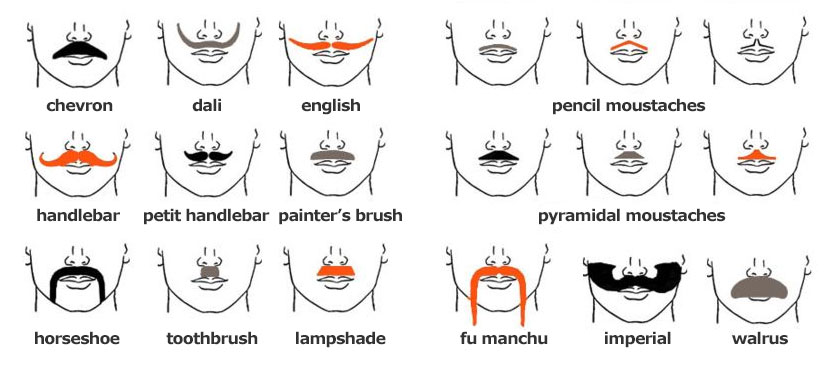Moustaches and other facial hair can give a face a completely different appearance. Some people like it, others hate it.
In certain cultures and historical periods, moustaches are seen as a symbol of virility. A celtic warrior without a moustache is an abnormality, so make sure the display mannequin depicting the warrior has a moustache as well. In professions where men want to radiate authority, such as the army and police, an above average amount of moustaches are worn.
Our moustaches, beards and sideburns are hand knotted. You can adhere the beards and moustaches with double-sided tape or glue.
In the images below, the same head has been given different moustaches.
Common moustache styles

Some facts about shaving and facial hair in history
c. 30,000 BC: Ancient cave paintings often depict men without beards, and suggest that people shaved or removed unwanted hair with clamshells, which were used like tweezers, or with blades made of flint.
c. 3000 BC: Copper razors arrived in India and Egypt.
c. 3000–332 BC: Ancient Egyptian nobles shaved their heads and bodies because they highly valued hairlessness. Remember: Back then, lice and staying clean was more of a challenge. However, men (and sometimes women) of noble birth wore artificial beards as a sign of divinity. (The god Osiris wore a beard.) Wigs were also common to protect the head from the sun.
c. 2900–500 BC: Mesopotamian rulers and elites wore beards, which were signs of masculinity and strength.
c. 1500–1200 BC: Scandinavian burial mounds contain elaborate bronze razors with handles shaped like the heads of horses.
c. 800 BC–600 AD: The Ancient Greeks were proud of their beards. The ability to grow a full beard at that time was a sign of high status and wisdom. (Many Greek men wished to emulate the gods Zeus and Heracles, both who were shown with huge beards.) Greeks only cut their beards during times of mourning.
c. 400 BC: Ancient Romans reacted against the long, heavy beards of the Greeks, keeping their beards clipped and neat or shaving their beards completely. In the fourth century AD, Ammianus Marcellinus, a Roman soldier wrote, ‘Do you suppose that your beard creates brains …? Take my advice and shave it off at once; for that beard is a creator of lice and not of brains.’
400–300 BC: Alexander the Great was clean-shaven and encouraged his soldiers shave before battle, as beards could be grabbed by enemies in “hand-to-beard combat.”
c. 300 BC: Young Roman men celebrated their first shave in parties with gifts symbolizing the transition to adulthood. Roman men either went to the barber at the start of their days or had a live-in servant to help them shave. Romans let their beards grow when in mourning.
c. 50 BC: Julius Caesar plucked out his beard hairs, and many Roman men followed suit. (Ouch!)
c. 100 AD: Roman Emperor Hadrian revived the growing of beards throughout Rome, only because he wished to hide his blemished skin. However, the Romans’ attitudes toward beards would wax and wane through history. Though older men equated beards with wisdom, younger men thought the sight of a man with a full beard looked old and unkempt.
c. 793 AD–1066 AD: With the Vikings invading Britain, they depicted the Vikings as unruly in manner and looks with unkempt hair and beards. (This isn’t actually factual.) In reaction, the trend became beardless, once again.
Middle Ages: Beards went in and out of fashion depending on the habits of prominent men. English King Henry VII was beardless, and Henry VIII wore a beard. Many members of French royalty donned beards as well.
c. 1500: Many emerging Protestants grew beards as a demonstration against Catholicism (most priests were clean-shaven).
1930: The U.S. military prohibited beards because they prevent a tight seal for gas masks.
Source: www.almanac.com
How important were moustaches to military men?
As important as their weapons and rations, by any measure. By the 18th century, moustaches were seen to signify soldiers, and were commonly used to tell the difference between military men and mere civilians. And, since the days of King James I, the luscious handlebar had been enjoying a well-brushed, if aristocratic, heyday.
But a real turning point in the military might of the moustache came in India. It was the 19th century and the British Raj was in full colonial swing. The Indian population, who traditionally believe that a man’s facial hair is a sign of his innate virility, were growing out gigantic moustaches to assert their masculinity. Bigger, it seems, was definitely considered better.
The British Army, many of whom were buying into the stiff, clean-shaven upper-lipped sensibilities of the time, were having difficulty maintaining any order within the Indian troops — who considered them less than ‘real men’ given their disastrous lack of moustaches. Backed into a corner, the Brits fought back and took control with similarly big bristlers, and brought the style back to Blighty with them when they returned home.Source: www.thegentlemansjournal.com













